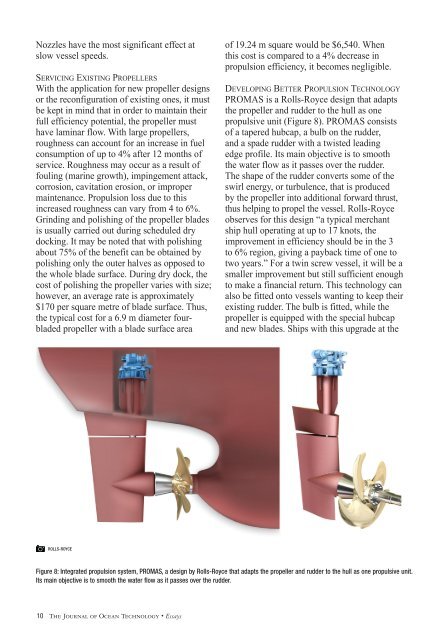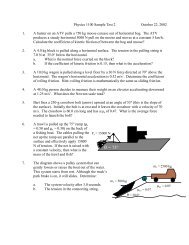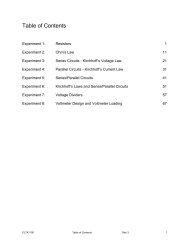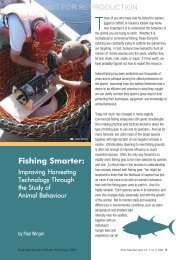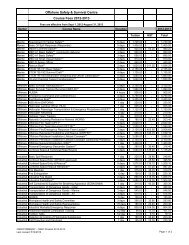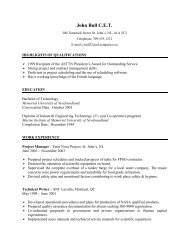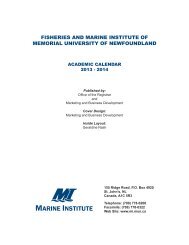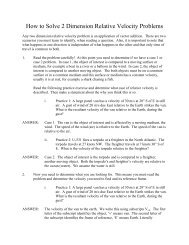Hybrid Marine Propulsion on the Tugboat Carolyn Dorothy
Hybrid Marine Propulsion on the Tugboat Carolyn Dorothy
Hybrid Marine Propulsion on the Tugboat Carolyn Dorothy
Create successful ePaper yourself
Turn your PDF publications into a flip-book with our unique Google optimized e-Paper software.
Nozzles have <strong>the</strong> most significant effect at<br />
slow vessel speeds.<br />
Servicing Existing Propellers<br />
With <strong>the</strong> applicati<strong>on</strong> for new propeller designs<br />
or <strong>the</strong> rec<strong>on</strong>figurati<strong>on</strong> of existing <strong>on</strong>es, it must<br />
be kept in mind that in order to maintain <strong>the</strong>ir<br />
full efficiency potential, <strong>the</strong> propeller must<br />
have laminar flow. With large propellers,<br />
roughness can account for an increase in fuel<br />
c<strong>on</strong>sumpti<strong>on</strong> of up to 4% after 12 m<strong>on</strong>ths of<br />
service. Roughness may occur as a result of<br />
fouling (marine growth), impingement attack,<br />
corrosi<strong>on</strong>, cavitati<strong>on</strong> erosi<strong>on</strong>, or improper<br />
maintenance. <str<strong>on</strong>g>Propulsi<strong>on</strong></str<strong>on</strong>g> loss due to this<br />
increased roughness can vary from 4 to 6%.<br />
Grinding and polishing of <strong>the</strong> propeller blades<br />
is usually carried out during scheduled dry<br />
docking. It may be noted that with polishing<br />
about 75% of <strong>the</strong> benefit can be obtained by<br />
polishing <strong>on</strong>ly <strong>the</strong> outer halves as opposed to<br />
<strong>the</strong> whole blade surface. During dry dock, <strong>the</strong><br />
cost of polishing <strong>the</strong> propeller varies with size;<br />
however, an average rate is approximately<br />
$170 per square metre of blade surface. Thus,<br />
<strong>the</strong> typical cost for a 6.9 m diameter fourbladed<br />
propeller with a blade surface area<br />
of 19.24 m square would be $6,540. When<br />
this cost is compared to a 4% decrease in<br />
propulsi<strong>on</strong> efficiency, it becomes negligible.<br />
Developing Better <str<strong>on</strong>g>Propulsi<strong>on</strong></str<strong>on</strong>g> Technology<br />
PROMAS is a Rolls-Royce design that adapts<br />
<strong>the</strong> propeller and rudder to <strong>the</strong> hull as <strong>on</strong>e<br />
propulsive unit (Figure 8). PROMAS c<strong>on</strong>sists<br />
of a tapered hubcap, a bulb <strong>on</strong> <strong>the</strong> rudder,<br />
and a spade rudder with a twisted leading<br />
edge profile. Its main objective is to smooth<br />
<strong>the</strong> water flow as it passes over <strong>the</strong> rudder.<br />
The shape of <strong>the</strong> rudder c<strong>on</strong>verts some of <strong>the</strong><br />
swirl energy, or turbulence, that is produced<br />
by <strong>the</strong> propeller into additi<strong>on</strong>al forward thrust,<br />
thus helping to propel <strong>the</strong> vessel. Rolls-Royce<br />
observes for this design “a typical merchant<br />
ship hull operating at up to 17 knots, <strong>the</strong><br />
improvement in efficiency should be in <strong>the</strong> 3<br />
to 6% regi<strong>on</strong>, giving a payback time of <strong>on</strong>e to<br />
two years.” For a twin screw vessel, it will be a<br />
smaller improvement but still sufficient enough<br />
to make a financial return. This technology can<br />
also be fitted <strong>on</strong>to vessels wanting to keep <strong>the</strong>ir<br />
existing rudder. The bulb is fitted, while <strong>the</strong><br />
propeller is equipped with <strong>the</strong> special hubcap<br />
and new blades. Ships with this upgrade at <strong>the</strong><br />
rolls-royce<br />
Figure 8: Integrated propulsi<strong>on</strong> system, PROMAS, a design by Rolls-Royce that adapts <strong>the</strong> propeller and rudder to <strong>the</strong> hull as <strong>on</strong>e propulsive unit.<br />
Its main objective is to smooth <strong>the</strong> water flow as it passes over <strong>the</strong> rudder.<br />
10 The Journal of Ocean Technology • Essays


